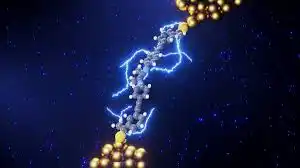افشین رشید
اُستادیار ؛ عضو هیات علمی دانشگاه آزاد اسلامی واحد علوم و تحقیقات تهران
597 یادداشت منتشر شدهThe Electromagnetic Nature of Nanoparticles

Note: The electromagnetic nature of nanoparticles in magnetic materials, the molecules and atoms that make them up have electromagnetic properties. In simpler terms, elements such as iron, cobalt, nickel and their alloys that are attracted by a magnet are called magnetic materials.
The classification of electromagnetic materials is based on magnetic susceptibility (the ability of a material to become magnetized). Based on this, materials are classified into three groups: ferromagnetic, paramagnetic, and diamagnetic. The resultant dipole moment in electromagnetic diamagnetic materials is zero, and in the presence of a magnetic field, a dipole moment is induced in them; but the direction of these induced dipoles is opposite to the direction of the external magnetic field, which causes the material (diamagnetic) to be repelled from the magnetic field. By removing the external magnetic field, the magnetic property of these materials does not remain. The magnetic susceptibility of these materials is negative and very low (about 6-10 - to 3-10 ). All gases (except oxygen), water, silver, gold, copper, diamond, graphite, bismuth, and many organic compounds are (diamagnetic). The magnetic dipoles in paramagnetic materials do not have a specific and regular orientation; as a result, these materials do not have magnetic properties. If they are placed in a magnetic field, they become regular along the magnetic field lines. When the magnetic field is removed , the magnetic dipoles quickly return to the previous state they had in the absence of the field. In this way, paramagnetic materials acquire magnetic properties in strong nanoelectromagnetic fields. The electromagnetic susceptibility of these materials is positive (about 10-6 to 10-1). (Manganese, platinum, aluminum, alkali and alkaline earth metals, oxygen and nitrogen oxides are nanoparamagnetic like paramagnetic materials . Ferromagnetic materials differ in that a set of magnetic dipoles are in the same direction and orientation, while these sets themselves are in different directions and orientations; so that they neutralize each other's field effect. This set of magnetic dipoles that are in the same direction is called a nanoelectromagnetic domain. The nanoelectromagnetic property of the particles of these materials depends on the speed of change of direction of these domains and their orientation in the direction of the field.

The magnetic property is highly dependent on the size of the particle. Any magnetic material in bulk is composed of magnetic domains. Each domain has thousands of atoms in which the direction of electron spin is the same and the magnetic moments are oriented parallel . However, the direction of electron spin in each domain is different from the other domains . Whenever a large magnetic field aligns all the magnetic domains, a nanoelectromagnetic phase change occurs and magnetization reaches saturation. Any particle that contains only one domain can be considered a nanoparticle. Magnetic nanoparticles have a small number of domains and are easier to magnetize.
Conclusion :
In ferromagnetic materials, when the particle size becomes smaller than a single magnetic domain, the phenomenon of superparamagnetism (the non-attachment of magnetic particles in nano-size under normal conditions and their high sensitivity to a magnetic field) occurs. Because nanoparticles do not require a large force to become magnetized, they do not deviate much from their natural state and, after becoming magnetized, do not have much tendency to lose their magnetic properties and return to their original state.